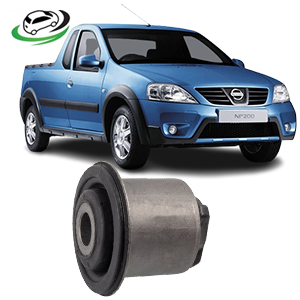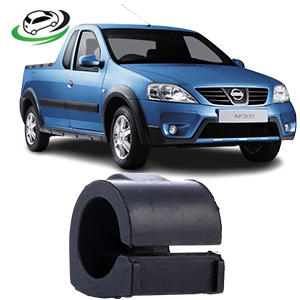-14%
Get Nissan Pick Up NP200 Bush-Stabilizer, Front 54613-00Q0B
The Bush-Stabilizer, Front, commonly known as the front stabilizer bushing or sway bar bushing, is an essential component of a vehicle’s suspension system. It helps in stabilizing the vehicle by connecting the sway bar (also known as the anti-roll bar or stabilizer bar) to the chassis and allowing controlled movement of the suspension while absorbing vibrations and reducing noise. The front stabilizer bushing ensures that the sway bar functions effectively in reducing body roll during cornering, improving both handling and comfort.
In this detailed explanation, we will delve into the structure, function, types, benefits, maintenance, and signs of failure for the front stabilizer bushing.
Structure of the Front Stabilizer Bushing
The front stabilizer bushing is a relatively simple but crucial part of the suspension system, composed of the following key elements:
- Rubber or Polyurethane Material: The core component of the stabilizer bushing is the material it’s made from, usually rubber or polyurethane. Rubber is the most common material, known for its flexibility and ability to absorb road shocks and vibrations. Polyurethane bushings, on the other hand, are harder and more durable, providing enhanced performance, especially for sports or off-road vehicles.
- Inner Sleeve: Some stabilizer bushings come with an inner metal sleeve, which provides a stable connection between the sway bar and the bushing itself. The sleeve reduces wear and ensures smooth movement.
- Split or Solid Design: Front stabilizer bushings come in either a split design (which makes installation easier by allowing them to be wrapped around the sway bar) or a solid design that requires disassembly of the sway bar for installation.
- Mounting Bracket: The bushing is typically secured in place by a metal bracket that clamps it tightly to the vehicle’s chassis. This bracket helps to prevent the bushing from shifting or moving out of place during vehicle operation.
Function of the Front Stabilizer Bushing
The primary role of the front stabilizer bushing is to support the sway bar and allow it to function correctly by connecting it to the chassis. The sway bar plays a critical role in controlling body roll during cornering, and the bushing ensures that it performs this function smoothly. Here’s a breakdown of the specific functions of the front stabilizer bushing:
- Absorbing Vibrations and Shocks: As the vehicle moves over bumps or uneven terrain, the sway bar shifts and moves to stabilize the car. The front stabilizer bushing absorbs much of the vibration and shock that occurs when the sway bar moves, preventing these forces from being transmitted to the vehicle’s chassis and, ultimately, to the passengers.
- Reducing Noise: Without a bushing, metal-to-metal contact between the sway bar and the chassis would result in loud clunking or rattling sounds during driving. The bushing dampens these noises, providing a quieter and more comfortable ride.
- Allowing Controlled Suspension Movement: The bushing allows the sway bar to move slightly within its mount, providing the necessary flexibility for the suspension to absorb bumps and maintain stability. By permitting controlled movement, the bushing helps the sway bar balance the suspension on both sides of the vehicle, reducing body roll during turns.
- Stabilizing the Vehicle During Cornering: During cornering, the vehicle’s body tends to lean or roll to one side due to centrifugal force. The sway bar, supported by the front stabilizer bushing, resists this body roll by transferring forces from one side of the suspension to the other. The bushing ensures that this process occurs smoothly, improving vehicle handling and safety.
- Maintaining Alignment of the Sway Bar: The bushing holds the sway bar in place and keeps it aligned with the chassis, preventing excessive movement that could affect handling or cause wear on other suspension components.
Types of Front Stabilizer Bushings
There are several types of front stabilizer bushings, each with distinct characteristics based on the material and design:
- Rubber Bushings: Rubber bushings are the most common and are often used in standard passenger vehicles. They provide excellent vibration dampening and noise reduction, offering a comfortable ride. However, rubber bushings tend to wear out over time, especially in harsh driving conditions or extreme weather.
- Polyurethane Bushings: Polyurethane bushings are stiffer and more durable than rubber bushings. They are often used in performance or off-road vehicles where enhanced handling and durability are required. Polyurethane bushings provide better control and responsiveness but may transmit more noise and vibrations to the cabin compared to rubber bushings.
- Split Bushings: Split bushings are designed with a gap or slit that allows them to be installed around the sway bar without the need to remove the sway bar from the vehicle. This design makes installation easier and faster, particularly during maintenance or replacement.
- Solid Bushings: Solid bushings are more durable but require the sway bar to be removed during installation. These bushings are often used in high-performance applications where maximum durability and stability are needed.
- Adjustable Bushings: In some high-performance or aftermarket applications, adjustable bushings are available. These allow for fine-tuning of the suspension system based on driving preferences or track conditions.
Importance of Front Stabilizer Bushings
The front stabilizer bushing plays a critical role in several aspects of vehicle performance and safety:
- Enhanced Handling and Stability: The primary function of the front stabilizer bushing is to reduce body roll during cornering, which helps to maintain stability and improve handling. By keeping the vehicle level and reducing body sway, the bushing ensures that the tires maintain optimal contact with the road, enhancing traction and control.
- Increased Ride Comfort: By absorbing shocks and vibrations, the front stabilizer bushing contributes to a smoother ride. Passengers experience less jarring from road imperfections, leading to a more comfortable driving experience.
- Reduced Wear on Other Suspension Components: The bushing helps prevent excessive movement of the sway bar, reducing wear on other suspension components, such as control arms, shocks, and struts. This helps prolong the life of the suspension system and reduces the need for costly repairs.
- Improved Safety: By maintaining vehicle stability during sharp turns or sudden maneuvers, the front stabilizer bushing enhances safety. A worn or damaged bushing can lead to increased body roll and reduced control, making the vehicle more susceptible to accidents.
- Noise Reduction: A well-functioning front stabilizer bushing reduces noise by preventing metal-to-metal contact between the sway bar and the chassis. This results in a quieter, more pleasant driving experience.
Maintenance of Front Stabilizer Bushings
Regular maintenance of the front stabilizer bushing is crucial for ensuring optimal suspension performance and preventing premature wear. Here are some key maintenance tips:
- Routine Inspections: During regular vehicle maintenance, it’s important to inspect the front stabilizer bushings for signs of wear, cracking, or deterioration. Rubber bushings, in particular, can dry out and crack over time, especially in extreme climates or rough driving conditions.
- Check for Noise: If you hear clunking, rattling, or squeaking noises coming from the front suspension, it could indicate that the front stabilizer bushings are worn or damaged. These noises often occur when the bushing has deteriorated to the point where the sway bar is contacting the metal components of the suspension.
- Replace Worn Bushings: Front stabilizer bushings should be replaced if they show signs of wear or damage. Worn bushings can lead to increased body roll, reduced handling performance, and excessive noise. Depending on the type of bushing and driving conditions, replacement may be necessary every 50,000 to 100,000 miles.
- Lubrication (for Polyurethane Bushings): Polyurethane bushings may require periodic lubrication to prevent squeaking and reduce friction. Be sure to use a lubricant that is compatible with the material of the bushing, as some lubricants can degrade rubber or polyurethane.
- Check for Alignment: Proper alignment of the sway bar and bushings is essential for optimal suspension performance. Misaligned or improperly installed bushings can lead to premature wear and affect vehicle handling.
Symptoms of Failing Front Stabilizer Bushings
Several symptoms can indicate that your front stabilizer bushings are failing, including:
- Excessive Body Roll: If you notice that your vehicle leans excessively during cornering or feels unstable when turning, it could be a sign that the front stabilizer bushings are worn and no longer providing adequate support for the sway bar.
- Clunking or Rattling Noises: A common symptom of worn stabilizer bushings is clunking or rattling noises coming from the front suspension, especially when driving over bumps or uneven surfaces. These noises occur when the sway bar moves excessively due to worn or damaged bushings.
- Increased Vibration: Worn bushings may not absorb vibrations as effectively, leading to increased vibrations felt in the cabin, particularly when driving over rough roads.
- Uneven Tire Wear: If the front stabilizer bushings are worn, the suspension may not be properly aligned, leading to uneven tire wear. This can reduce the life of your tires and negatively impact handling.
- Visual Damage: A visual inspection of the bushings can reveal signs of wear, such as cracks, tears, or excessive movement. If the bushing appears dry, cracked, or damaged, it should be replaced.
Conclusion
The Front Stabilizer Bushing is a vital part of a vehicle’s suspension system, responsible for stabilizing the sway bar, reducing body roll, and absorbing shocks and vibrations. By allowing the sway bar to function effectively, the bushing enhances handling, ride comfort, and overall vehicle safety. Proper maintenance, regular inspections, and timely replacement of worn bushings are essential for ensuring the longevity and performance of the suspension system. Recognizing the signs of failing bushings, such as excessive body roll, noise, and uneven tire wear, can help you maintain optimal vehicle performance and safety.
Follow us on Facebook for more parts.



